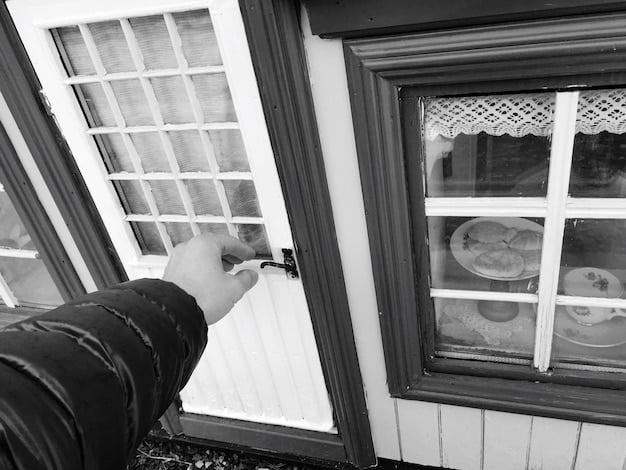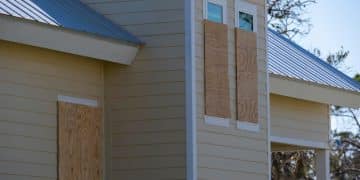Save $300 Annually: Seal Drafty Windows Before Winter

Save $300 annually by sealing drafty windows before winter can be achieved through easy DIY methods like applying weather stripping, caulking, and using window film, all designed to block drafts and improve your home’s energy efficiency, leading to significant savings.
As winter approaches, homeowners often dread the rising energy bills. Did you know that drafty windows are a major culprit? You can save $300 annually by sealing drafty windows before winter. Let’s explore a step-by-step guide to help you minimize heat loss and maximize your savings.
Identify Drafty Windows
Before you can start sealing your windows, it’s essential to identify which ones are the most problematic. Locating the sources of drafts will ensure that you focus your efforts where they’re needed most, maximizing your energy-saving potential.
The Candle Test
A simple yet effective method to identify drafty windows is the candle test. On a calm day, light a candle and slowly move it around the edges of your window frames. If the flame flickers or dances, it indicates a draft. Mark these areas for sealing.
Feel for Airflow
Another straightforward approach is to simply feel for airflow. On a cold day, run your hand along the window frames, sashes, and glass. If you feel a noticeable breeze or cold spot, that’s a sign of a draft. Pay close attention to corners and where the window meets the wall.
- Check Window Locks: Ensure the window locks are functioning correctly. If the window doesn’t lock tightly, it can create gaps.
- Inspect the Trim: Look for gaps or cracks in the window trim both inside and outside your home.
- Assess the Caulking: Check the existing caulking around the window frame for cracks or deterioration.
- Evaluate Weather Stripping: Examine the weather stripping for wear and tear. If it’s brittle or compressed, it needs replacement.
Identifying drafty windows is the first step in improving your home’s energy efficiency. By pinpointing these problem areas, you can strategically seal them, preventing heat loss and saving money on your energy bills.

Gather Your Supplies
Once you’ve identified the drafty windows, it’s time to gather the necessary supplies. Having the right materials on hand will make the sealing process smoother and more effective. Here’s a list of essential items you’ll need:
Weather Stripping
Weather stripping is used to seal gaps between the window sash and the frame. There are several types available, including foam, felt, vinyl, and metal. Choose the one that best suits your window type and the size of the gap.
Caulk and Caulk Gun
Caulk is used to seal gaps and cracks around the window frame where it meets the wall. Silicone caulk is a durable and waterproof option. A caulk gun will make applying the caulk easier and more precise. Make sure the caulk is suitable for exterior use if sealing outside gaps.
- Utility Knife: For removing old caulk and trimming weather stripping.
- Measuring Tape: To measure the length of weather stripping needed.
- Cleaning Supplies: Including a scraper, brush, and cleaning solution to prepare surfaces.
- Safety Glasses and Gloves: To protect your eyes and hands during the sealing process.
Gathering the right supplies is crucial for effective window sealing. Having these items readily available will streamline the process, ensuring that you can quickly and efficiently seal your windows, reducing drafts, and saving energy.
Prepare the Window Frames
Before applying any sealing materials, it’s essential to prepare the window frames properly. Clean surfaces ensure better adhesion and a longer-lasting seal. A well-prepared window frame will prevent drafts more effectively.
Remove Old Caulk and Weather Stripping
Start by removing any old caulk or weather stripping. Use a utility knife or scraper to carefully peel away the old materials. Be thorough to ensure there’s a clean surface for the new sealant.
Clean the Surfaces
Once the old materials are removed, clean the window frames thoroughly. Use a brush and cleaning solution to remove any dirt, dust, or debris. Make sure the surfaces are completely dry before proceeding.
- Inspect for Damage: Check the window frames for any signs of rot or damage. Address any necessary repairs before sealing.
- Sand Rough Spots: If there are rough spots on the window frame, lightly sand them down for a smoother surface.
- Ensure Dryness: Make sure the window frames are completely dry before applying weather stripping or caulk.
Proper preparation of window frames guarantees that the new sealing materials adhere effectively. By taking these preparatory steps, you enhance the durability and effectiveness of your sealing efforts, reducing drafts and improving your home’s energy efficiency.
Apply Weather Stripping
With the window frames prepared, it’s time to apply weather stripping. This step involves sealing the gaps between the window sash and the frame, preventing air leakage. Proper weather stripping ensures a tight seal and maximizes energy savings.
Measure and Cut
Begin by measuring the sections of the window frame where you’ll be applying the weather stripping. Cut the weather stripping to the appropriate lengths using scissors or a utility knife.
Apply the Weather Stripping
Peel off the adhesive backing (if applicable) and carefully apply the weather stripping to the window frame. Press firmly to ensure a secure bond. For non-adhesive types, use small nails or staples to hold the stripping in place.
- Start at the Top: Begin applying weather stripping at the top of the window frame and work your way down.
- Ensure Tight Fit: Make sure the weather stripping fits snugly against the window sash to create a tight seal.
- Overlap at Corners: Overlap the weather stripping at the corners for a continuous seal.
- Test the Seal: After applying the weather stripping, close the window and check for any remaining drafts.
Applying weather stripping effectively closes the gaps that allow cold air to enter your home. By following these steps, you can significantly reduce drafts, improve your home’s energy efficiency, and potentially save a substantial amount on your annual heating costs.

Caulk Around the Window Frame
Caulking is essential for sealing gaps and cracks around the window frame where it meets the wall. This prevents air leaks and moisture intrusion. A well-caulked window frame ensures a tighter seal and added protection against the elements.
Load the Caulk Gun
Start by loading the caulk tube into the caulk gun. Cut the tip of the caulk tube at a 45-degree angle and puncture the seal with a nail or wire. Twist the plunger rod to apply adequate pressure.
Apply the Caulk
Hold the caulk gun at a consistent angle and apply a steady bead of caulk along the gaps and cracks between the window frame and the wall. Maintain even pressure to control the flow of caulk.
- Smooth the Caulk: After applying the caulk, use a wet finger or a caulking tool to smooth the bead for a professional finish.
- Clean Up Excess: Wipe away any excess caulk with a damp cloth.
- Allow to Dry: Allow the caulk to dry completely according to the manufacturer’s instructions, typically 24-48 hours.
- Inspect the Seal: After drying, inspect the caulk for any gaps or cracks and reapply if necessary.
Caulking is a simple yet impactful way to seal your windows and prevent drafts. By properly caulking around the window frame, you create an airtight barrier that keeps cold air out and warm air in, ultimately contributing to energy savings.
Consider Window Film
In addition to weather stripping and caulking, consider using window film for an extra layer of insulation. Window film can help reduce heat loss through the glass itself. This option offers a cost-effective way to enhance your windows’ energy efficiency.
Measure and Cut the Film
Measure the window pane and cut the window film slightly larger than the measured area. This allows for easy trimming after application. Precise measurements ensure a better fit and appearance.
Apply the Film
Clean the window thoroughly and spray it with water. Peel off the backing from the window film and apply it to the wet glass. Use a squeegee to smooth out any bubbles and trim the excess film with a utility knife.
- Use a Heat Gun: For some types of window film, using a heat gun can help shrink the film for a tighter fit.
- Apply Even Pressure: When using a squeegee, apply even pressure to avoid damaging the film.
- Inspect for Bubbles: Check for any remaining bubbles and smooth them out with the squeegee.
- Allow to Cure: Allow the window film to cure completely according to the manufacturer’s instructions.
Window film provides an additional barrier against heat loss, complementing your weather stripping and caulking efforts. By adding this layer, you further enhance your windows’ insulation, leading to even greater energy savings and preventing drafts throughout the winter months.
| Key Point | Brief Description |
|---|---|
| 🔍 Identify Drafts | Use a candle or feel the airflow to find drafty windows. |
| 🛠️ Gather Supplies | Collect weather stripping, caulk, a caulk gun, and cleaning tools. |
| 🧽 Prepare Frames | Remove old materials and clean surfaces for better adhesion. |
| 🎬 Apply Film | Add window film for an extra layer of insulation and further energy savings. |
Frequently Asked Questions
▼
Drafty windows allow cold air to enter during the winter and warm air during the summer, forcing your heating and cooling systems to work harder to maintain a comfortable temperature. This extra effort leads to higher energy bills.
▼
The best type of weather stripping depends on your window type and the size of the gap. Foam and felt are suitable for smaller gaps, while vinyl and metal are more durable for larger gaps. Consider your specific needs.
▼
It’s best to apply caulk in temperatures above 40°F (4°C) because caulk adheres better in warmer conditions. Cold temperatures can cause the caulk to become brittle and less effective. Check the manufacturer’s recommendation.
▼
Weather stripping and caulk should be inspected annually and replaced as needed. Typically, they last between 3 to 5 years, depending on the quality of the materials and exposure to the elements. Look for signs of wear.
▼
Yes, window film can be a worthwhile investment. It adds an extra layer of insulation, reduces heat loss, and can block harmful UV rays. It’s a cost-effective way to improve your home’s energy efficiency and comfort, especially during winter.
Conclusion
Sealing drafty windows is a straightforward and highly effective way to reduce energy bills and improve home comfort. By identifying drafty windows, gathering the right supplies, and following the steps outlined in this guide, you can save $300 annually by sealing drafty windows before winter. Take these simple measures and enjoy a warmer, more energy-efficient home this winter.





